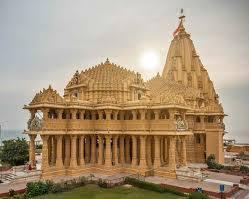
The Somnath Temple, located in the Prabhas Patan near Veraval in Saurashtra, on the western coast of Gujarat, India, is one of the most significant and revered temples in Hinduism. Its history is steeped in mythology and tradition, making it a centrepiece in the Indian cultural and religious landscape.
Mythological Significance:
According to Hindu tradition, the Somnath Temple is the first among the twelve Aadi Jyotirlingas of India. A Jyotirlinga is a devotional representation of Lord Shiva, where Shiva is worshipped as a fiery column of light. According to the Shiva Purana, the Moon God (Chandra) married 27 daughters of Daksha Prajapati, but favored only one, Rohini. The other daughters complained to their father, who cursed Chandra to wane into nothingness. Chandra then worshipped Shiva at Prabhas Patan, and Shiva relieved him of the curse, partially, thus causing the periodic waning of the moon. This legend is central to the temple's spiritual significance.
Historical Timeline:
The temple's history is marked by repeated destruction and reconstruction. It is believed to have been first built in gold by the Moon God, in silver by Ravana, in wood by Krishna, and in stone by the Solanki Rajputs in the 11th century. The most notable destruction came at the hands of Mahmud of Ghazni in 1026 AD, who plundered the temple for its wealth. It was subsequently rebuilt several times, with the present structure dating back to 1951, when it was reconstructed under the orders of Sardar Vallabhbhai Patel.
Architectural Splendor:
The architecture of the Somnath Temple is a beautiful example of the Chalukya style, characterized by intricate carvings and a Kailash Mahameru Prasad style. The temple's shikhara (spire) soars to a height of about 50 meters. The temple complex also houses an impressive Sabha Mandap (audience hall), which stands on 64 pillars, each intricately carved with figures of mythological importance. Cultural Impact: Over the years, the Somnath Temple has not only been a place of religious significance but also a symbol of Hindu resilience and pride. Its history of being rebuilt after repeated destructions is seen as a testament to the enduring nature of Indian culture and Hindu faith.
Modern Day Relevance:
Today, the Somnath Temple continues to be a major pilgrimage site, attracting millions of devotees and tourists from around the world. It also plays a crucial role in the cultural and spiritual landscape of India, hosting various religious festivals and events throughout the year.
Darshan:
The Somnath Temple is open to all Hindus. Darshan (viewing the deity) is the main activity at the temple. Darshan timings are from 6:00 AM to 8:00 PM.